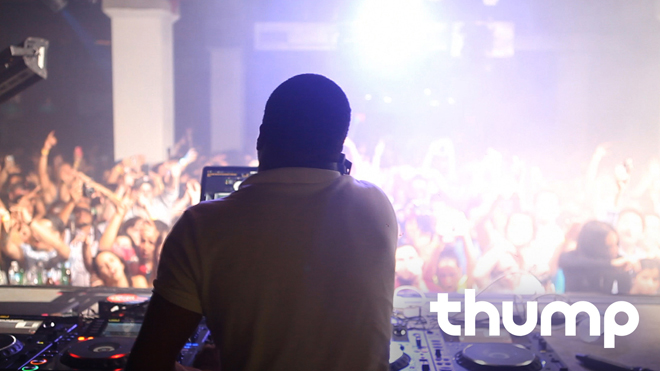Within the scope of dance music in cinema, the fan almost seems secondary. But for the pieces that do focus on the fan perspective, from Depeche Mode documentary 101 to Human Traffic and even Second Summer of Love footage, the audience senses the subjects’ passion for the sounds. Unfortunately, for the recent THUMP documentary Blackout: Sex, Hugs & EDM, this never emerges.
Considering THUMP is part of VICE, the magazine that has employed and given a byline to poor-little-rich-girl-cokehead Cat Marnell, Dori Oskowitz’s 30-minute documentary fares better than expected on the surface. Rather than follow a bunch of drunken revelers wanting bottle service around New York City or simply go to Electric Daisy Carnival and focus on any ditzy coed in neon shorts, Blackout starts off with some legitimacy: shots of DJs spanning mainstream and underground genres and across venues from an empty-church-turned-dance-party venue to midsize performance halls. The viewer gets introduced to club scenes all over the world, from Detroit and New York to Mexico, Chile, Berlin, Paris, and Tokyo and meets a range of producers from Richie Hawtin to Krewella and Baauer.
Throughout the footage, the variety strings together a dance music narrative often thought to have been cut off by mainstream DJs preferring stadiums and other large venues to more intimate clubs and warehouses. From Above & Beyond’s obsessive fans to Dada Life performing in a midrange venue to more traditional clubs, the experience painted appears universal across the dance music spectrum.
However, beyond these points going for it, Blackout falters in one significant regard: A documentary that should be about fans doesn’t explain why listeners of electronic dance music love it so much. Instead, viewers get treated to the Bass Bunnies – two club kids from New York who, from how the documentary depicts them, go to bass shows to simply look cute; there’s no reason they couldn’t have pulled their shtick at a house or techno show – or even a bar that plays solely top 40 and hip-hop, for that matter.
At the same time, juxtaposed with brainless hot chicks putting on clothes or dancing are brief cuts of diehard fans, like Above & Beyond’s or those who’s want an autographed teapot from Cajmere. We see them shrieking after the trance trio and later Curtis Jones signing the item, but at no time does the film go after why a listener or clubgoer would be drawn to Above & Beyond’s mellow sounds or clamor after an underground DJ.
 Rather than continue to follow the fans’ perspectives or investigate how electronic dance music’s various forms influence a venue and crowd, Blackout takes a night out as its structure, offering glimpses of how clubs all over the world vary but still have similarities. Footage of a wide range of subjects starts from getting ready at home, or for a few producers and DJs, preparing before the show, and then travels to the venue, literally going on public transit or a cab ride. At this point, however, Oskowitz takes the easy route: Clips from all such venues and experiences get frenetically spliced together at a seizure-inducing speed that you might as well be watching a basic music video. Considering dance music videos have been moving away from the club or concert theme, this approach has a dated feel, but manages to take up at least a quarter of Blackout’s time.
Rather than continue to follow the fans’ perspectives or investigate how electronic dance music’s various forms influence a venue and crowd, Blackout takes a night out as its structure, offering glimpses of how clubs all over the world vary but still have similarities. Footage of a wide range of subjects starts from getting ready at home, or for a few producers and DJs, preparing before the show, and then travels to the venue, literally going on public transit or a cab ride. At this point, however, Oskowitz takes the easy route: Clips from all such venues and experiences get frenetically spliced together at a seizure-inducing speed that you might as well be watching a basic music video. Considering dance music videos have been moving away from the club or concert theme, this approach has a dated feel, but manages to take up at least a quarter of Blackout’s time.
At this point, these has to be some kind of closure, and THUMP does this by showing clubbers and DJs leave in the early hours of the morning, the concerts ending, or police coming to crack down on a party.
If you’re looking to find out why someone gets drawn to electronic dance music in this day and age, Blackout feels unsatisfying to previous time periods. 101 captured the fervor behind mainstream yet still experimental synthpop in the ‘80s, while Human Traffic’s script let the viewer know why the late ‘90s and early ‘00s were a perfect time to go out to a club or warehouse party. If the latest progression of dance music doesn’t want to come off as mindless and vapid, Blackout doesn’t do it any favors.




